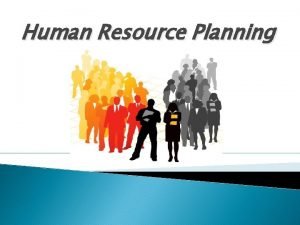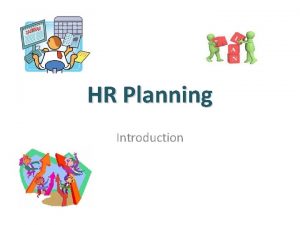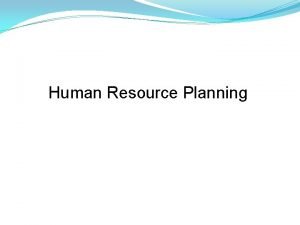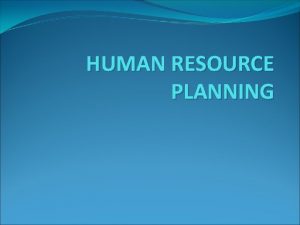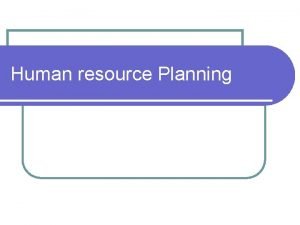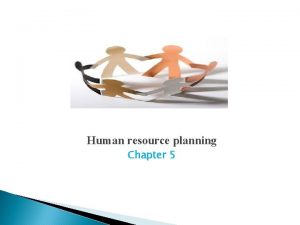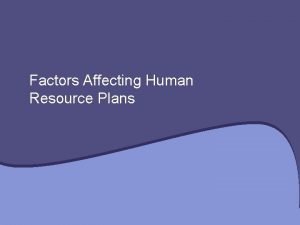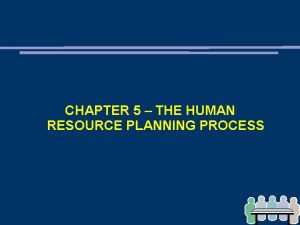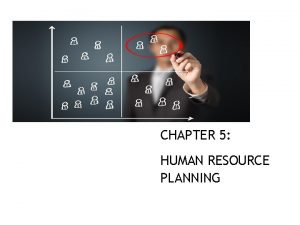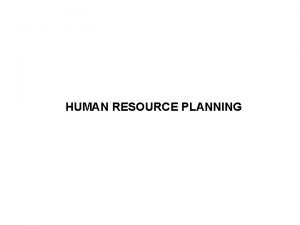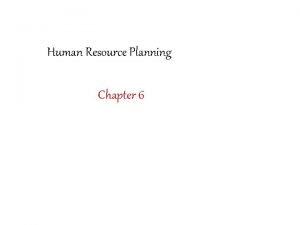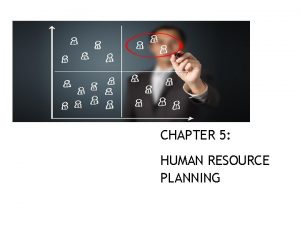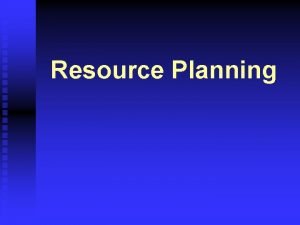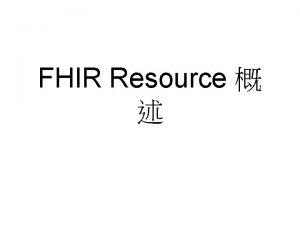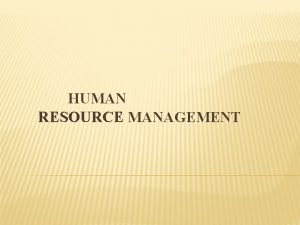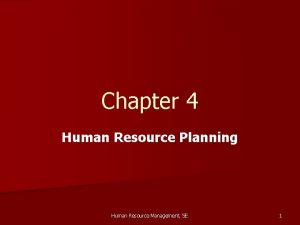Human Resource Planning Introduction Human resources planning is














- Slides: 14

Human Resource Planning

Introduction: • • Human resources planning is done to achieve the optimum use of human resources and to have the correct number and type of employees needed to meet organizational goal. According to Geisler, “Manpower planning is the process including forecasting, developing and controlling by which a firm ensures that it has – The right number of people, – The right kind of people, – At the right places, – At the right time, doing work for which they are economically most useful”.

Human Resource Planning Interfacing with planning and scanning the environment. Taking an inventory of the company’s current human resources. Forecasting demand for human resources. Forecasting the supply of HR. Comparing forecasts of demand supply. Planning the actions needed to deal with anticipated shortage or overages. Feed back such information into the planning process. Succession Planning. Talent Management. Cost-Benefit Analysis

Human Resources Planning Model:

Link 1: Determine Demand: How many people need to be working and in what jobs to implement organizational strategies and attain organizational objectives. Involves forecasting HR needs based on organizational objectives. Link 2: Determine HR Supply: Choose HRM programs. Involves forecasting or predicting effect of various HR programs on employee flowing into, through and out various job classifications. First determine how well existing programs are doing then forecast what additional programs or combination of programs will do. Need to know capabilities of various programs and program combinations

Determine Feasibility Links 3 & 4 Capable of being done: ◦ Requires knowledge of programs, how programs fit together and external environmental constraints (e. g. , labor force, labor unions, technology created skill shortages) and internal environmental constraints (skill shortages within the organization, financial resources, managerial attitudes, culture) • Do the benefits outweigh the costs: Difficulty in quantifying costs and benefits.

Organizational Objectives and Strategies Link 5: “If no feasible HR program can be devised, the organization must revise strategic plans. ”

Human Resource Forecasting: Process of projecting the organization’s future HR needs (demand) and how it will meet those needs (supply) under a given set of assumptions about the organization’s policies and the environmental conditions in which it operates.

SWOT Analysis Strength: Weakness: Opportunities: Threats: • Competition. • Experienced, resourceful, dedicated Workforce. • Proactive management team. • Capable Management. • Well performed employee. • Rapid growth • “Personnel” is allowing for more creative and flexible options. • Advanced technologies are available to foster more effective human resources activities. • Budget constraints. • Poor position in management : Reactive rather than pro-active work. • Changes in technology. • Social factors. • Economic climate.

Special Feature: Upper management better aware. Personnel cost is controlled. Less time to locate talent. Affirmative Action Plan implemented Time to develop employees. Create reservoir of talent. Prepares people for future. Succession Planning.

Values: Support of organization’s goals. Increased retention Higher performance More innovation/better economics Increased self-esteem An employee who feels more valued A more committed, engaged analyst Strengthened bond between the analyst and manager A more focused manager.

Target Market: In Bangladesh there are many organization does not follow the Human Resource Planning properly. So those organization would be our target market. As for example: Pharmaceutical Company. Bank. Education. Garment Industries. Telecom Company. Restaurant. Software Company etc.

The best success we can have in getting managers and supervisors to recognize employees more often is less a function of awareness of the importance of recognition and the skills of providing recognition and more a function of getting managers to personally experience the power of recognition.

Thank You
 Human resource planning introduction
Human resource planning introduction What is planning
What is planning New approaches to organizing hr
New approaches to organizing hr Chapter 1 introduction to human resource management
Chapter 1 introduction to human resource management Introduction to human resource management
Introduction to human resource management Definition human resource management
Definition human resource management Managerial judgement technique in hrm example
Managerial judgement technique in hrm example Short term hr planning
Short term hr planning Meaning of human resource planning
Meaning of human resource planning Human resource planning meaning
Human resource planning meaning Human resource planning definition
Human resource planning definition Steps of human resource planning
Steps of human resource planning Human resource management question paper
Human resource management question paper Factors affecting human resource management
Factors affecting human resource management Forecasting techniques in human resource planning
Forecasting techniques in human resource planning
